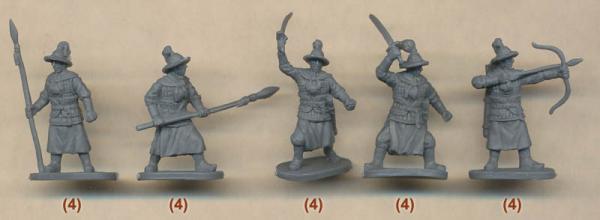Home › Forums › Historical Tabletop Game Discussions › Gaming in China’s History › Reply To: Gaming in China’s History
A quick post about the miniatures available in 1/72 from Caesar Miniatures


This set from Caesar represents the army of the Qin (also spelt Ch’in) – one of many warring states – who succeeded in subduing all others to form a united empire under the First Emperor in 221 BCE. The Qin dynasty that followed was short lived (only 14 years), but it was a major landmark in Chinese history, and the army that achieved that success is known to us today largely through the discovery of the Terracotta Army in Xi’an.


For those unfamiliar with the long history of China, the Ming dynasty ruled from 1368 to 1644. It overthrew the previous Mongol Yuan dynasty that had been established by Khubilai in the 13th century, but for much of its long history it still found itself fighting the Mongols. Other military adventures included combating pirates along the coast and suppressing internal revolts, and of course the expedition to Korea in the 1590s to fight the Japanese.


Qing dynasty, which ruled China from 1644 to 1911, and by using the term ‘troopers’ it doesn’t even specify if we are talking infantry or cavalry. In Europe 1644 saw armies walk on to the battlefield with massed ranks of pikes, and 1911 saw them building up their stocks of machine guns and aircraft, so this is an enormous period with much change. Certainly China was pretty backward in 1644, and had stagnated since, but even there armies and military technology had changed to a degree over these two-and-a-half centuries.


The Han dynasty was the imperial ruling family of China between 206 BCE and 220 CE, and followed on from the collapse of the Qin dynasty that had briefly unified much of China for the first time. Its story was one of expansion into neighboring territories, consolidation of existing holdings and allied states, and dealing with threats and aggression from other peoples or internal revolts. Today it is seen as something of a golden age in Chinese history.


For China World War II has a rather different significance to that in the rest of the world. China had been more or less at war for many years, with revolutions and fighting between parties and warlords taking their toll, while the 1931 Japanese invasion and occupation of Manchuria led to a kind of low-level war with her aggressive neighbour that suddenly became full-scale when Japanese forces invaded and conquered large parts of China from 1937. When Japan attacked the USA and the British Empire in 1941 China became one of the allied powers, but in large measure left the final defeat of Japan to the westerners. The years 1941 to 1945 were mainly ones of stalemate, when large Japanese resources that could have been useful elsewhere were tied down in China, but the Chinese also husbanded their strength for what most expected to be a renewed civil war between nationalist and communist once the Japanese menace was removed.
All text and images have come from the website Plastic Soldier Review.







































































